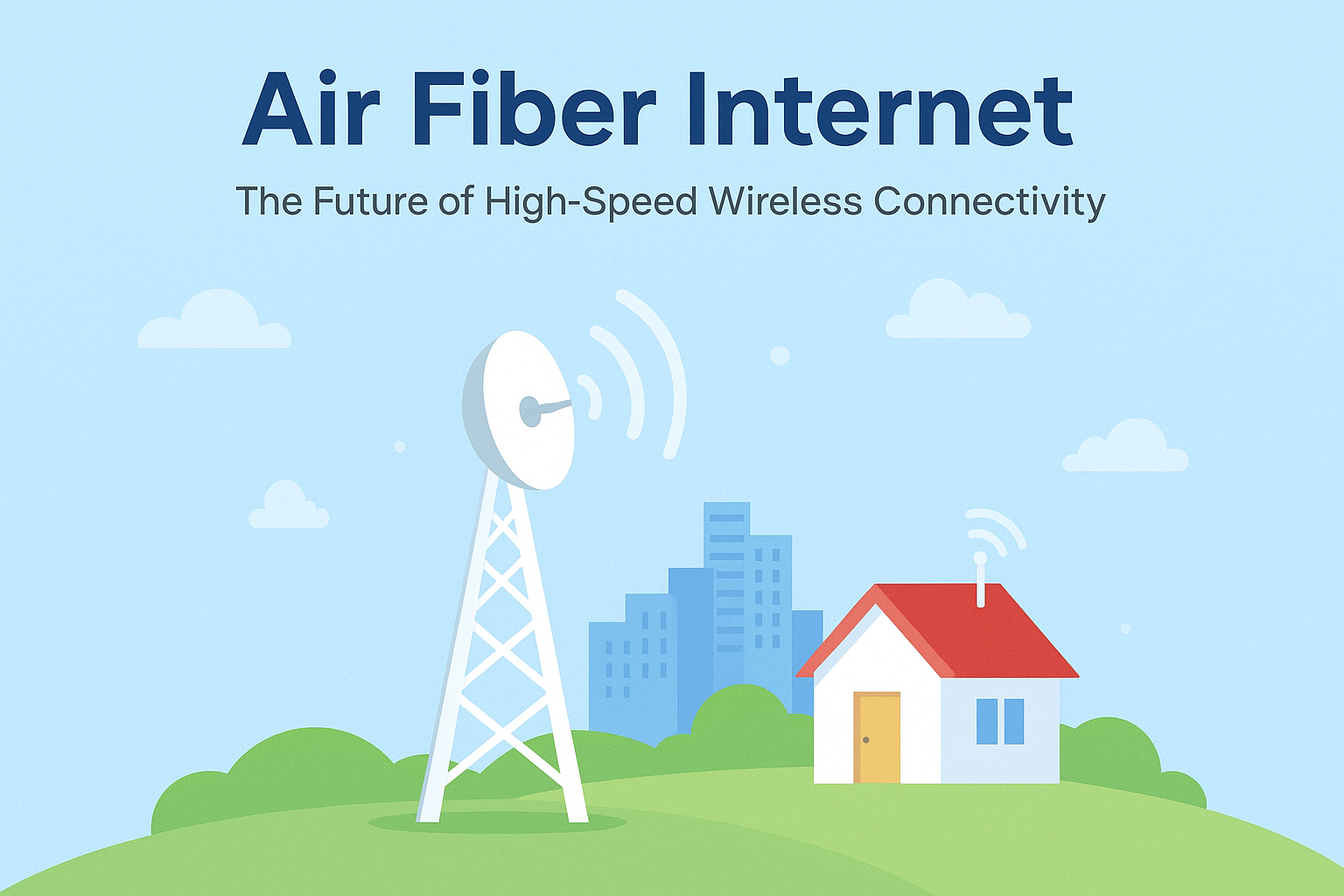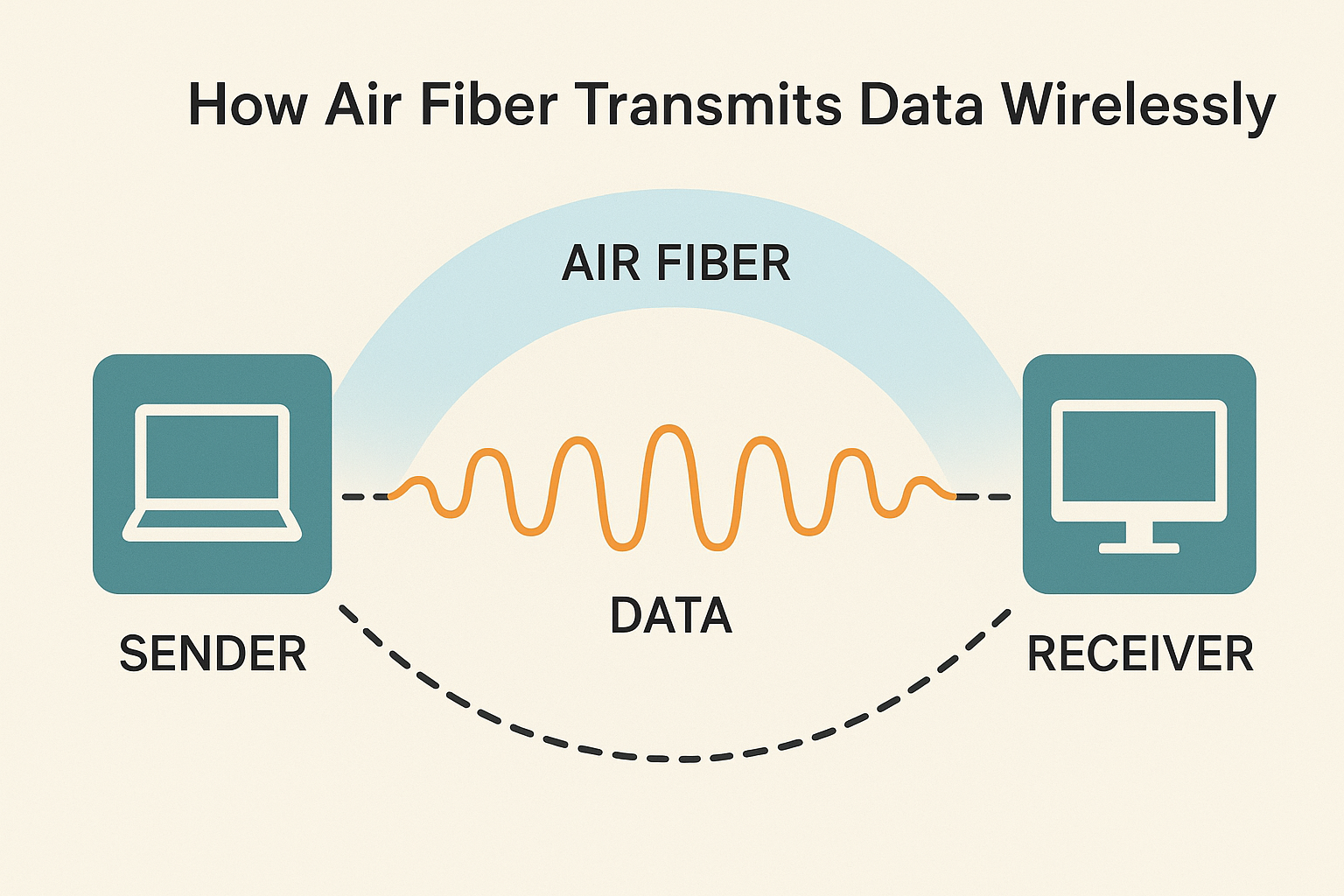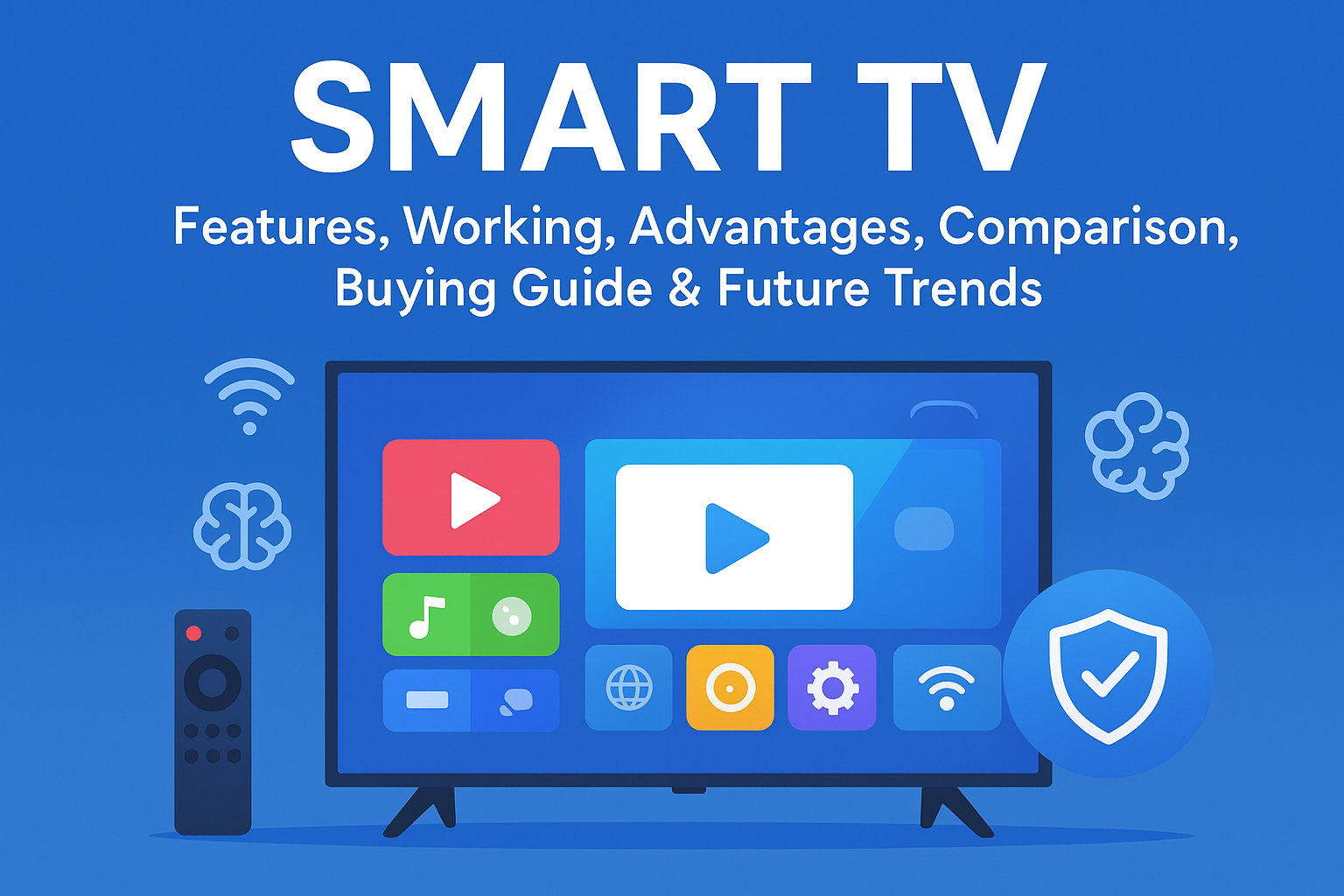Air Fiber: The Future of Wireless High-Speed Internet
A complete guide on Air Fiber technology, working, advantages, and future impact in India and beyond.
What is Air Fiber?
Air Fiber is an advanced wireless broadband technology that delivers high-speed internet
connectivity without the need for traditional fiber cables. Instead of underground wiring,
Air Fiber uses radio waves or microwave frequencies to transmit internet data between two
points — typically between an internet tower and the user’s receiver antenna.
It is often called “wireless fiber” because it offers speeds similar to
fiber-optic broadband but through air transmission. The technology allows service providers
to extend internet access to remote or rural areas where laying cables is either costly or
geographically challenging.
Why Air Fiber is Gaining Popularity
The increasing need for fast, stable, and affordable internet has driven the rise of
Air Fiber services. In many developing regions, especially in countries like India,
the cost and time required to lay fiber-optic cables are major barriers.
Air Fiber solves this issue by using wireless line-of-sight communication
that can be deployed in a matter of hours instead of weeks or months.
Companies like Jio and Airtel have already started
offering Air Fiber services, which promise gigabit-level speeds without any physical cable
connection to your home. This technology is transforming how broadband is delivered,
particularly in areas with difficult terrains or dense urban setups.
Air Fiber vs Traditional Broadband
Traditional broadband relies on physical cables — either copper (DSL) or fiber optics —
to transmit data. While this method is reliable, it comes with high infrastructure costs
and lengthy installation processes.
In contrast, Air Fiber transmits data through air using fixed antennas. As long as
there’s a clear line of sight between the service tower and the receiver, users can
enjoy seamless high-speed internet. This makes it ideal for both urban and rural areas
where cable installation is not feasible.
| Feature |
Traditional Broadband |
Air Fiber |
| Connection Type |
Wired (Copper/Fiber Cable) |
Wireless (Radio/Microwave) |
| Installation Time |
Several Days or Weeks |
Few Hours |
| Coverage |
Limited by Cable Reach |
Wide, Especially Rural Areas |
| Maintenance |
High (Cable Faults Common) |
Low (No Physical Lines) |
| Speed |
Up to 1 Gbps (Fiber) |
Up to 1 Gbps or Higher |
How Air Fiber Works – The Technology Behind Wireless Broadband
Understanding the mechanism, components, and science that make Air Fiber an advanced alternative to wired broadband.
1. The Core Working Principle
Air Fiber technology operates on the principle of fixed wireless communication.
It uses radio or microwave frequency bands to transmit internet data between a service provider’s
transmission tower and the user’s receiver antenna, all through air.
Data is sent as high-frequency radio signals which travel in a straight line, meaning that
the connection requires a clear Line of Sight (LoS) between both ends.
Once received, these signals are converted back into digital data to provide fast, stable
internet access, similar to a fiber-optic connection.
2. Main Components of Air Fiber Setup
- Transmission Tower (Base Station): The central point that sends and receives data. It’s connected to the main fiber backbone of the internet.
- Customer Premises Equipment (CPE): A receiver antenna or device installed at the user’s location to capture the transmitted signal.
- Radio Units or Antennas: Devices that transmit and receive signals between towers and user devices.
- Router or Modem: Converts the signal received from the antenna into usable internet for devices like phones, PCs, and smart TVs.
- Power Source and Mounting: Antennas and devices are powered and fixed on rooftops or poles for optimal signal direction.
3. Step-by-Step Data Transmission Process
-
Step 1: The service provider’s main tower connects to the global internet through a fiber backbone.
-
Step 2: The tower transmits high-frequency radio waves carrying internet data toward a user’s receiver device.
-
Step 3: The receiver antenna (CPE) captures these signals and sends them to the user’s router.
-
Step 4: The router converts signals into usable Wi-Fi or LAN connectivity.
-
Step 5: Data is exchanged back and forth at ultra-fast speeds, giving users a seamless internet experience without any physical cable.
4. Frequency Bands and Speed
Air Fiber typically operates on licensed or unlicensed frequency bands such as
2.4 GHz, 5 GHz, 11 GHz, 24 GHz, and 60 GHz. The higher the frequency,
the faster the potential data transfer — but shorter the coverage distance.
Providers like Jio AirFiber and Airtel use modern millimeter-wave (mmWave)
frequencies that can deliver speeds up to 1 Gbps or more within a limited range.
These frequencies ensure low latency and high reliability when aligned correctly.
5. Line of Sight (LoS) Importance
A key technical requirement of Air Fiber is the presence of an uninterrupted
Line of Sight between the transmission tower and the receiver antenna.
Any obstacle such as trees, tall buildings, or hills can weaken or block the signal completely.
For this reason, service providers usually mount antennas on rooftops or poles at
specific angles to maintain a perfect line of sight. In some advanced systems,
beamforming technology is used to automatically adjust signal direction
and minimize data loss.
6. Typical Coverage Range
Depending on the equipment and frequency used, Air Fiber coverage can range from
1 km to over 20 km in clear conditions. Urban areas usually have shorter ranges
due to obstructions, while rural or open regions can achieve longer connections.
High-capacity setups, especially for enterprise or government use, can even establish
point-to-point links covering multiple kilometers without degradation in quality.
Types of Air Fiber Connections and Comparison with Fiber Broadband
Learn about different Air Fiber setups and how they compare with traditional fiber-based internet.
1. Point-to-Point (P2P) Connection
A Point-to-Point (P2P) connection links two specific locations through a direct wireless signal.
It’s like creating a private, invisible cable between two antennas.
This setup is commonly used for enterprise networks, government offices, or data centers that need a
dedicated and secure line between two distant sites.
The biggest benefit of P2P Air Fiber is stability and speed. Since the connection
is exclusive to a pair of endpoints, it avoids congestion and ensures constant performance.
2. Point-to-Multipoint (P2MP) Connection
The Point-to-Multipoint (P2MP) configuration is where one base station connects with multiple
receiver antennas at different user locations. It’s ideal for providing wireless broadband to multiple homes,
offices, or small businesses from a single tower.
This is the model used by most Internet Service Providers (ISPs) offering Air Fiber to
consumers. The central tower acts as the “hub,” and each user’s antenna acts as a “spoke,” forming a network
of wireless connections.
Although bandwidth is shared among users, proper configuration can ensure stable and consistent performance,
especially when advanced technologies like TDMA (Time Division Multiple Access) or
beamforming are used.
3. Fixed Wireless Access (FWA)
Fixed Wireless Access (FWA) is a modern implementation of Air Fiber that provides
home or office broadband through fixed antennas connected to nearby towers.
Unlike mobile networks, FWA connections are stationary, giving them much higher speed and reliability.
FWA is one of the most efficient ways to deliver 5G-level internet speeds without
laying cables, making it a perfect choice for rural and suburban areas.
Many telecom giants — including Jio and Airtel — are actively deploying
FWA-based Air Fiber across India.
4. Air Fiber vs Fiber Optic Broadband – A Complete Comparison
Although both Air Fiber and traditional fiber broadband deliver high-speed internet, they work very differently.
Fiber-optic connections depend on underground or overhead cables made of glass fibers that transmit light signals,
while Air Fiber transmits the same data over radio frequencies through the air.
The comparison below highlights their major differences based on speed, cost, installation, and other parameters.
| Category |
Air Fiber |
Fiber Optic Broadband |
| Medium |
Wireless (Radio / Microwave) |
Wired (Optical Fiber Cable) |
| Installation Time |
Few hours (no trenching required) |
Days or weeks (depends on cabling) |
| Speed |
Up to 1 Gbps or higher |
Up to 1–10 Gbps |
| Latency |
Low (5–20 ms average) |
Very low (1–10 ms) |
| Cost of Setup |
Cheaper (wireless deployment) |
Expensive (requires physical cables) |
| Maintenance |
Low (less physical damage risk) |
High (cable faults common) |
| Suitability |
Best for rural and semi-urban areas |
Best for dense urban networks |
| Scalability |
Easy — just add antennas |
Complex — new cables needed |
| Weather Impact |
Moderate (signal affected by rain/fog) |
Negligible (protected cables) |
| Reliability |
High but depends on line-of-sight |
Very high with stable fiber links |
In summary, Air Fiber is faster to deploy and highly cost-effective,
while fiber broadband offers slightly better reliability and latency.
Both technologies are likely to coexist, serving different types of users and locations.
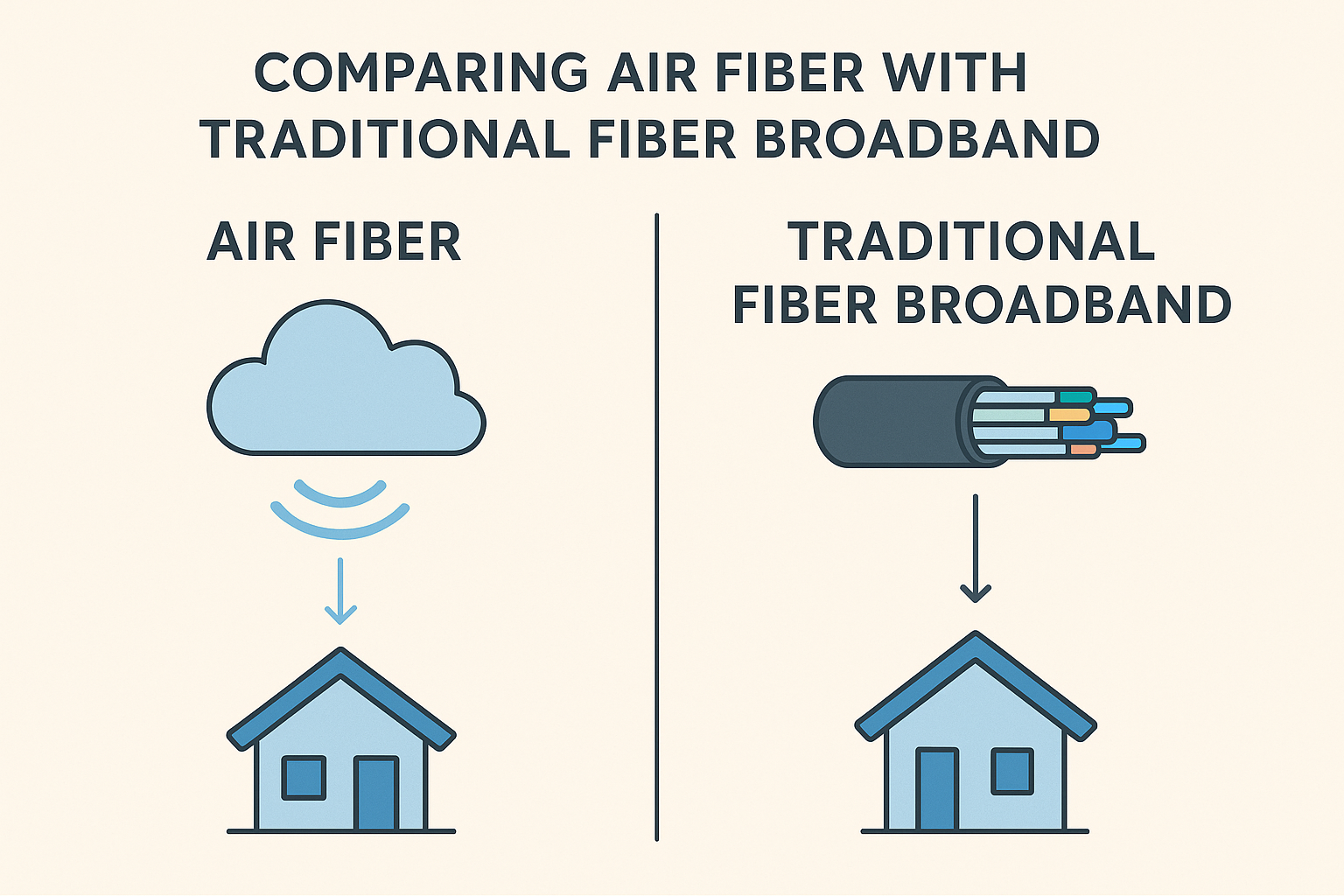
Advantages, Limitations, and Real-World Applications of Air Fiber
Discover the benefits that make Air Fiber revolutionary and understand its real-world challenges and usage.
1. Key Advantages of Air Fiber Internet
Air Fiber offers several advantages over traditional wired broadband technologies.
Its flexibility, fast deployment, and affordability make it a preferred solution for
both service providers and end-users, especially in areas with limited fiber infrastructure.
-
1. Fast Deployment: Unlike fiber cables that require trenching or wiring,
Air Fiber connections can be set up within a few hours using antennas and line-of-sight alignment.
-
2. Cost-Effective Setup: Air Fiber saves a large amount of installation and
maintenance costs. Service providers don’t need to dig roads or lay cables, making it ideal for
semi-urban or rural rollouts.
-
3. High-Speed Connectivity: Air Fiber delivers internet speeds comparable to fiber broadband,
reaching up to 1 Gbps or more under ideal conditions.
-
4. Scalability: Expanding an Air Fiber network is simple. Providers can add more
antennas or base stations without needing additional underground wiring.
-
5. Minimal Maintenance: Since there are no physical cables, the chances of
damage from weather, rodents, or construction work are significantly reduced.
-
6. Great for Remote Locations: Air Fiber is ideal for connecting
rural or geographically challenging areas where fiber deployment is not viable.
-
7. Stable and Consistent Speeds: Using modern radio technology and dedicated links,
Air Fiber ensures low latency and stable performance even during heavy usage hours.
-
8. Eco-Friendly: With reduced physical infrastructure, Air Fiber
minimizes environmental impact compared to traditional broadband.
2. Disadvantages and Limitations
While Air Fiber is an innovative technology, it also has some drawbacks that need to be considered before adoption.
These limitations usually depend on environmental conditions and technical configurations.
-
1. Weather Sensitivity: Heavy rain, fog, or dust can affect radio signal quality,
leading to slower speeds or temporary connection drops.
-
2. Line-of-Sight Dependency: Air Fiber requires a clear visual path between the tower and the receiver.
Any obstruction — like trees, buildings, or hills — can weaken or completely block the signal.
-
3. Limited Range: The coverage of an Air Fiber connection is typically between
1–20 km, depending on the equipment and frequency used.
-
4. Potential Interference: Other wireless devices or nearby transmission towers operating on similar
frequencies may interfere with signal strength and stability.
-
5. Speed Variation: Since Air Fiber often uses shared frequency channels, speed can vary
slightly based on distance and number of active users.
-
6. Installation Angle Sensitivity: Misalignment of antennas or incorrect mounting
can reduce performance drastically, requiring professional setup and calibration.
3. Real-World Applications of Air Fiber
Air Fiber has a wide range of applications across different sectors, making it one of the
most adaptable forms of internet technology available today. It bridges the connectivity
gap between cities and rural regions efficiently.
🏠 Residential Use
Air Fiber provides households with high-speed, reliable broadband without the
need for underground fiber. It supports online classes, OTT streaming, and
remote work seamlessly.
🏢 Commercial and Industrial Use
Businesses use Air Fiber for branch connectivity, real-time data transmission,
cloud computing, and surveillance systems in warehouses or industrial parks.
🏫 Educational Institutions
Schools and colleges in rural areas use Air Fiber to access online learning
platforms and conduct digital classes without depending on expensive wired networks.
🌾 Rural and Remote Connectivity
Governments and ISPs deploy Air Fiber to bring broadband access to villages,
healthcare centers, and panchayats under digital inclusion initiatives.
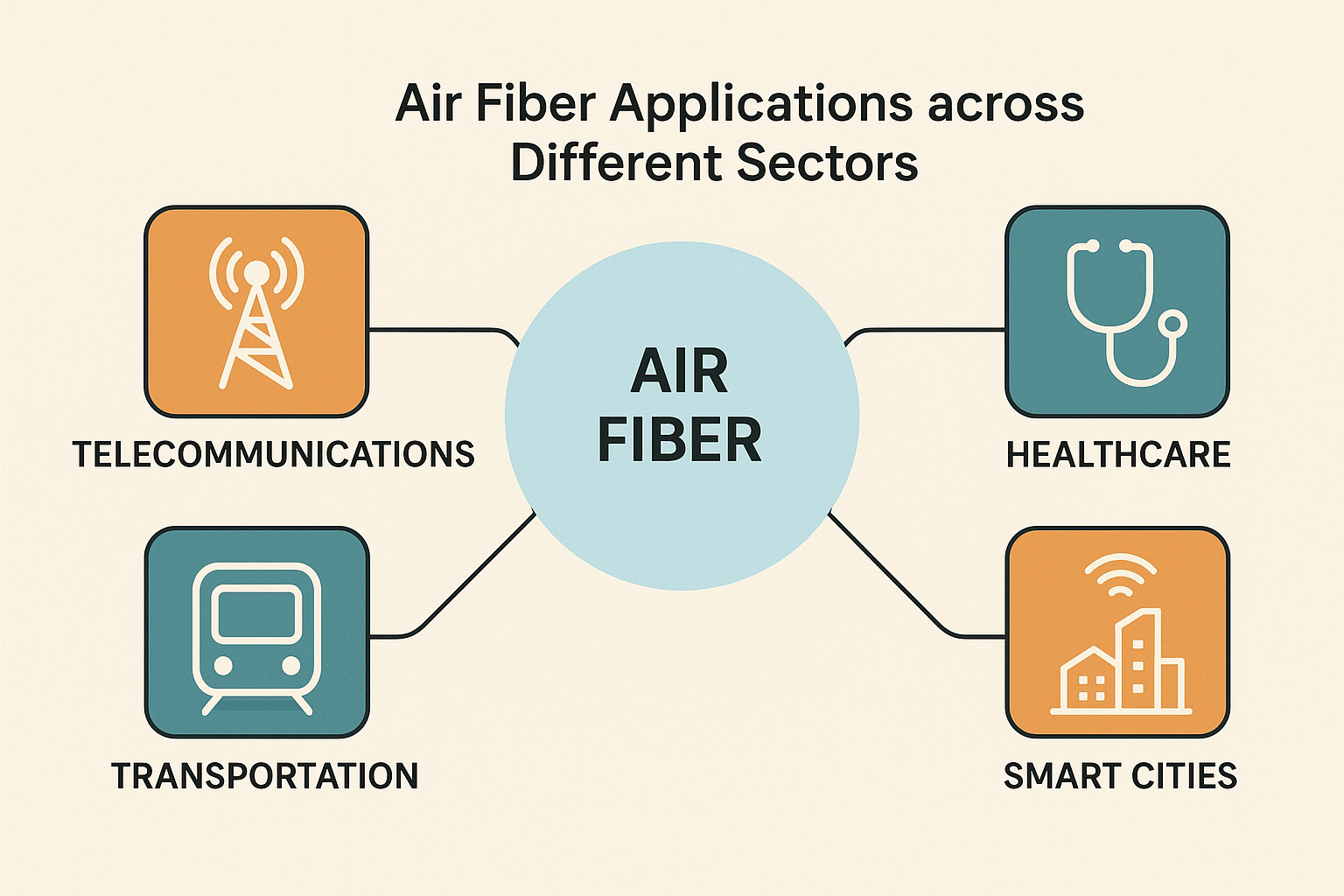
Advantages of Air Fiber Technology
Air Fiber brings several benefits that make it a game-changer for both individual users and businesses.
Below are some of the key advantages that make this technology highly preferred over conventional broadband.
1. High-Speed Internet Connectivity
Air Fiber provides internet speeds that can rival fiber-optic connections, reaching up to 1 Gbps in many cases.
This high speed enables seamless 4K video streaming, online gaming, and uninterrupted video conferencing.
2. Quick and Easy Deployment
Unlike traditional fiber, Air Fiber does not require underground cabling or digging.
It can be deployed rapidly by installing antennas or receivers on rooftops, towers, or poles.
This makes it ideal for emergency setups or rural connectivity projects.
3. Cost-Effective Setup
Since there’s no need for extensive civil work or cabling, the setup cost is significantly lower than fiber networks.
Both service providers and consumers benefit from this affordability.
4. Scalable and Flexible
Air Fiber networks can be easily expanded to cover new areas or add more users.
The system’s modular nature allows service providers to scale operations based on demand without large infrastructure investments.
5. Suitable for Remote and Rural Areas
One of the biggest challenges of fiber internet is reaching rural areas where laying cables is impractical.
Air Fiber bridges this gap, offering high-speed connectivity in remote locations without physical lines.
6. Reliable and Stable Connection
With advanced frequency management, Air Fiber provides stable connectivity even during peak usage hours.
It also resists interference better than traditional wireless broadband, thanks to adaptive signal technologies.
Challenges and Limitations of Air Fiber
While Air Fiber is a promising technology, it also faces certain challenges that can affect performance or adoption.
1. Line-of-Sight Requirement
Air Fiber needs a clear, unobstructed line of sight between antennas or access points.
Tall buildings, trees, or hills can cause signal interruptions, affecting reliability in urban or uneven terrains.
2. Weather Sensitivity
Rain, fog, or dust storms can weaken radio signals, leading to reduced performance or temporary disruptions.
Modern systems are improving in this regard, but weather remains a factor in some cases.
3. Limited Coverage Area
Each Air Fiber base station covers a specific radius, usually between 5–20 kilometers, depending on terrain and equipment.
Beyond this, additional towers or repeaters are needed.
4. Initial Equipment Cost for Users
Although the installation is easy, users need specific receiver equipment like antennas or modems.
The initial cost can be slightly higher compared to basic broadband setups.
The Future of Air Fiber Technology
The future of Air Fiber looks extremely bright, especially with the growth of smart cities, digital transformation,
and the increasing demand for high-speed internet in every part of the world.
1. Integration with 5G Networks
Air Fiber can complement 5G by providing a strong backbone in areas where laying fiber cables isn’t practical.
Combined, these technologies can deliver ultra-low latency and multi-gigabit speeds.
2. AI and IoT Expansion
With smart devices and IoT networks expanding rapidly, Air Fiber offers the perfect infrastructure for
fast data transmission and inter-device communication.
3. Rural Connectivity Revolution
Governments and private providers are investing heavily in Air Fiber to bridge the digital divide.
India, Africa, and many developing regions are already seeing major rollouts of Air Fiber networks.
4. Green and Sustainable Technology
Unlike traditional cable networks, Air Fiber reduces the need for large-scale construction, making it more environmentally friendly.
It consumes less energy and materials, contributing to sustainable development.
Frequently Asked Questions (FAQs)
Q1. What is the difference between Air Fiber and normal broadband?
Normal broadband uses wired connections (fiber or copper), while Air Fiber uses radio signals to transmit data wirelessly.
Air Fiber is faster to deploy and can reach areas where broadband cannot.
Q2. Is Air Fiber as fast as fiber broadband?
In most modern systems, yes. Air Fiber can deliver speeds up to 1 Gbps, similar to optical fiber, though
performance may vary slightly based on distance and environment.
Q3. Can Air Fiber work during rain or bad weather?
Generally, yes — though very heavy rain or storms can slightly affect signal strength.
Newer Air Fiber systems are built to withstand most weather conditions efficiently.
Q4. What equipment do I need for Air Fiber?
Users typically need an outdoor receiver antenna, an indoor router, and a small power adapter or PoE injector
provided by the service provider.
Q5. Is Air Fiber safe?
Yes. Air Fiber uses regulated frequency bands that comply with global safety standards.
The radio waves used are non-ionizing and safe for humans and the environment.
Conclusion
Air Fiber is revolutionizing the way we think about internet connectivity. It offers a combination of
high speed, low cost, and easy deployment, making it a top choice for both urban and rural users.
With ongoing advancements and integration with future technologies like 5G and IoT, Air Fiber
is set to become one of the most important digital infrastructures of the next decade.
In short, Air Fiber represents the perfect blend of innovation and accessibility —
bringing the world closer to truly universal, high-speed internet.
